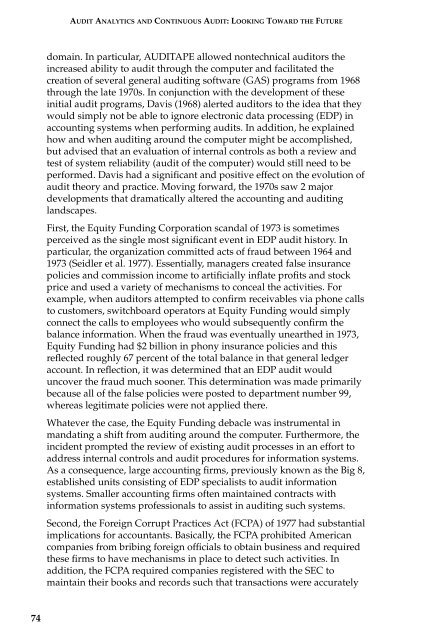AUDIT ANALYTICS AUDIT
1JWn3ix
1JWn3ix
You also want an ePaper? Increase the reach of your titles
YUMPU automatically turns print PDFs into web optimized ePapers that Google loves.
<strong>AUDIT</strong> <strong>ANALYTICS</strong> AND CONTINUOUS <strong>AUDIT</strong>:LOOKING TOWARD THE FUTURE<br />
domain. In particular, <strong>AUDIT</strong>APE allowed nontechnical auditors the<br />
increased ability to audit through the computer and facilitated the<br />
creation of several general auditing software (GAS) programs from 1968<br />
through the late 1970s. In conjunction with the development of these<br />
initial audit programs, Davis (1968) alerted auditors to the idea that they<br />
would simply not be able to ignore electronic data processing (EDP) in<br />
accounting systems when performing audits. In addition, he explained<br />
how and when auditing around the computer might be accomplished,<br />
but advised that an evaluation of internal controls as both a review and<br />
test of system reliability (audit of the computer) would still need to be<br />
performed. Davis had a significant and positive effect on the evolution of<br />
audit theory and practice. Moving forward, the 1970s saw 2 major<br />
developments that dramatically altered the accounting and auditing<br />
landscapes.<br />
First, the Equity Funding Corporation scandal of 1973 is sometimes<br />
perceived as the single most significant event in EDP audit history. In<br />
particular, the organization committed acts of fraud between 1964 and<br />
1973 (Seidler et al. 1977). Essentially, managers created false insurance<br />
policies and commission income to artificially inflate profits and stock<br />
price and used a variety of mechanisms to conceal the activities. For<br />
example, when auditors attempted to confirm receivables via phone calls<br />
to customers, switchboard operators at Equity Funding would simply<br />
connect the calls to employees who would subsequently confirm the<br />
balance information. When the fraud was eventually unearthed in 1973,<br />
Equity Funding had $2 billion in phony insurance policies and this<br />
reflected roughly 67 percent of the total balance in that general ledger<br />
account. In reflection, it was determined that an EDP audit would<br />
uncover the fraud much sooner. This determination was made primarily<br />
because all of the false policies were posted to department number 99,<br />
whereas legitimate policies were not applied there.<br />
Whatever the case, the Equity Funding debacle was instrumental in<br />
mandating a shift from auditing around the computer. Furthermore, the<br />
incident prompted the review of existing audit processes in an effort to<br />
address internal controls and audit procedures for information systems.<br />
As a consequence, large accounting firms, previously known as the Big 8,<br />
established units consisting of EDP specialists to audit information<br />
systems. Smaller accounting firms often maintained contracts with<br />
information systems professionals to assist in auditing such systems.<br />
Second, the Foreign Corrupt Practices Act (FCPA) of 1977 had substantial<br />
implications for accountants. Basically, the FCPA prohibited American<br />
companies from bribing foreign officials to obtain business and required<br />
these firms to have mechanisms in place to detect such activities. In<br />
addition, the FCPA required companies registered with the SEC to<br />
maintain their books and records such that transactions were accurately<br />
74


